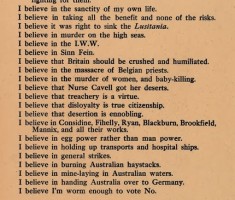By Cheryl Griffin.
“E’s been once wounded, somewhere in the leg…”
6906 Private Lawrence Joseph Smith enlisted on 18 July 1918 and served with the 22nd Infantry Battalion. His parents were William Smith, an overseer, and Letitia Josephine McLoughlin. He’d been born in Coburg, lived with his parents and siblings in Coke Street (later Cope Street), returned to the area after the war, married and settled in Pascoe Vale South where he lived the rest of his life.
Lawrence Smith, who called himself Larry, was wounded in the thigh on 19 May 1918 at Ville-sur-Ancre, which effectively ended his war.
 The ruins of Ville-sur-Ancre. The village was captured by the 6th Australian Infantry Brigade on 19 May 1918. Image courtesy AWM. Image E02821.
The ruins of Ville-sur-Ancre. The village was captured by the 6th Australian Infantry Brigade on 19 May 1918. Image courtesy AWM. Image E02821.
On his return to Australia, Smith resumed his earlier work as a postman and during World War Two again enlisted, serving at the Postal Unit in South Melbourne. He applied for a War Service Home Loan in 1925 with which he built his home in Fontaine Street, Pascoe Vale South. He lived there for the rest of his life.
A staunch Catholic, Larry Smith wrote a letter to a local politician in 1977 in which he made reference to a decision by Coburg Council in 1919 that reflects on the conscription debates of 1916/1917. It also makes clear that the Catholic/Protestant divide did more than separate school children into Protestant kids and Catholic kids chanting jibes at one another on their way to their respective schools.
Here in Coburg we can see an example of such feeling spilling over into decisions about the naming of streets, even in a subdivision where the land was owned originally by Father Charles O’Hea, bequeathed to the Catholic Church on his death in 1903 and subdivided under the supervision of Archbishop Mannix in 1918.
Smith wrote:
“Roosevelt Street was first called Mannix Street … after Dr Mannix had given the Coburg citizens five acres (quarry land) but for naught, his name was wiped off and Roosevelt substituted in the Motion of Cr W.E. Cash who claimed we had a disloyal man’s name on a street, that was gratitude.” (Coburg Historical Society Collection)
 1913 portrait of Archbishop Danniel Mannix, taken around the time he became Archbishop of Melbourne. Photographer unknown. Image courtesy SLV. Image H2011.20/78
1913 portrait of Archbishop Danniel Mannix, taken around the time he became Archbishop of Melbourne. Photographer unknown. Image courtesy SLV. Image H2011.20/78
At the time, the Catholic Press had plenty to say on the matter:
“The residents of old Pentridge, now Coburg, where the penal establishment of Melbourne is situated, are getting uppish. At the meeting of the public works committee of the Coburg Council last week, the surveyor read a list of names of proposed new streets in a subdivision of what is known as the Deanery Estate. He read out ‘Mercier Street’, remarking ‘That is evidently after Cardinal Mercier’. Next came ‘Mannix Street’ which the surveyor was proceeding to remark was named after _____ , when Councillor Dwerryhouse jumped up. ‘I protest against that,’ he said. ‘We want no Mannix Street in Coburg.’ ‘About Mercier Street?’ queried the surveyor. ‘Oh, that’s all right,’ shouted several councillors. ‘He’s a very different man.’ It was unanimously decided that the name ‘Mannix’ for the street should be deleted… After all, no genuine patriot would want to associate his name with a town called after the Grand Duke of Saxe-Coburg. ‘Dwerryhouse St.’ Great Norfolk! What a name it would make.” The Catholic Press (NSW), 12 December 1918, p.22 (also reported in the Argus, 6 December 1918, p.8 and a number of NSW papers)
Click here to see Archbishop Daniel Mannix talking about his anti-conscription stance during World War One. Mannix was a huge influence on the way Catholics voted in the referenda of 1916 and 1917.
The conscription debate almost tore communities apart. It was emotional and hard fought, as can be seen in the following posters.
 Anti-conscription leaflet entitled ‘The Blood Vote.’ Written by W.R. Winspear, and drawn by Claude Marquet. St Andrews Place, Sydney. Image courtesy AWM. Image RC00337.
Anti-conscription leaflet entitled ‘The Blood Vote.’ Written by W.R. Winspear, and drawn by Claude Marquet. St Andrews Place, Sydney. Image courtesy AWM. Image RC00337.
 1917. Black and white pro conscription poster. ‘The Anti’s Creed’, a litany of anti-Australian ‘beliefs’ alleged to be held by the anti-conscription supporters. Image courtesy AWM. Image RC00317.
1917. Black and white pro conscription poster. ‘The Anti’s Creed’, a litany of anti-Australian ‘beliefs’ alleged to be held by the anti-conscription supporters. Image courtesy AWM. Image RC00317.
 Black and white pro-conscription referendum leaflet targeting the female vote. An appeal by the Council of Women of Victoria. Image courtesy AWM. Image RC00319.
Black and white pro-conscription referendum leaflet targeting the female vote. An appeal by the Council of Women of Victoria. Image courtesy AWM. Image RC00319.